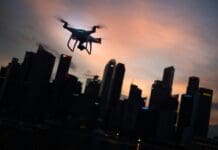This post is also available in:
 עברית (Hebrew)
עברית (Hebrew)

Virtually every country on Earth will be able to build or acquire drones capable of firing missiles within the next 10 years. Armed aerial drones will be used for targeted killings, terrorism and the government suppression of civil unrest. What’s worse, say experts, it’s too late for the United States to do anything about it.
After the past decade’s explosive growth, it may seem that the U.S. is the only country with missile-carrying drones. In fact, the U.S. is losing interest in further developing armed drone technology. The military plans to spend $2.4 billion on unmanned aerial vehicles, or UAVs, in 2015. That’s down considerably from the $5.7 billion that the military requested in the 2013 budget.
Other countries, conversely, have shown growing interest in making unmanned robot technology as deadly as possible. Only a handful of countries have armed flying drones today, including the U.S., United Kingdom, Israel, China and (possibly) Iran, Pakistan and Russia.
Unmanned systems conference 2014 – Israel
Other countries want them, including South Africa and India. So far, 23 countries have developed or are developing armed drones, according to a recent report from the RAND organization. It’s only a matter of time before the lethal technology spreads, several experts say. “Once countries like China start exporting these, they’re going to be everywhere really quickly. Within the next 10 years, every country will have these,” Noel Sharkey, a robotics and artificial intelligence professor from the University of Sheffield, told Defense One.
The biggest technology challenge in drone development also promises the biggest reward in terms cost savings and functionally: full autonomy. UAVs have limited ability to guide themselves and the development of fully autonomous drones is years away. But some recent breakthroughs are beginning to bear fruit. The experimental X-47B, a sizable drone that can fly off of aircraft carriers, demonstrated that some discrete tasks that are considered extremely difficult when performed by humans, can be mastered by machines with relative ease.



























